
|
Getting your Trinity Audio player ready...
|
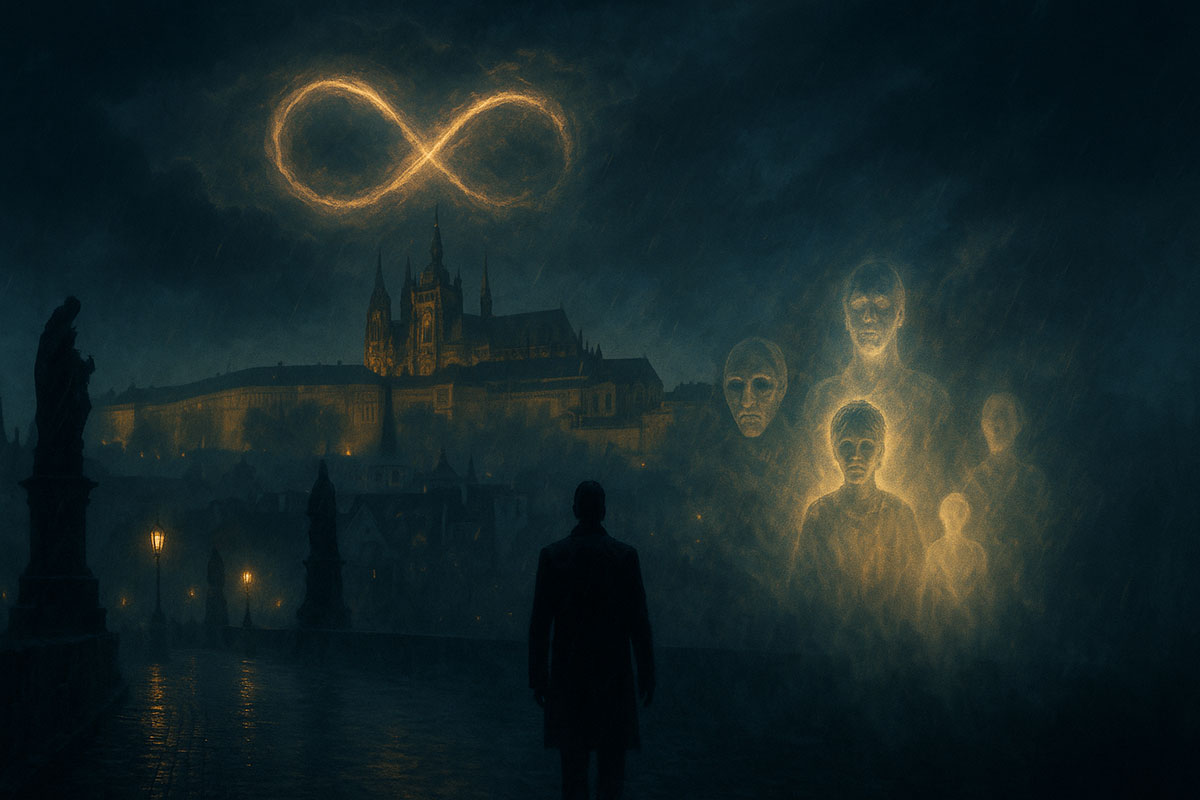
Introduction by Robert Langdon
For years, I studied symbols carved in stone and painted on canvas—halos, infinity knots, spirals of light—thinking they were metaphors for human longing. But in Prague, amid shadows of the Threshold Project, I began to wonder: what if these symbols were not metaphors at all, but messages?
The Secret of Secrets asked the oldest question of all: does consciousness survive death? Now, in this extraordinary gathering of voices—scientists, seekers, and even souls beyond the veil—we turn to that question directly. From Brigita’s testimony as a scientist beyond death, to the unmasking of the Golem, to councils of souls and frozen witnesses, we trace a path toward the infinity halo itself—the sign that consciousness endures.
I invite you to join me, not as a scholar of symbols, but as a fellow traveler at the threshold of life and beyond.
(Note: This is an imaginary conversation, a creative exploration of an idea, and not a real speech or event)

Topic 1: Brigita Speaks — The Scientist Beyond the Threshold
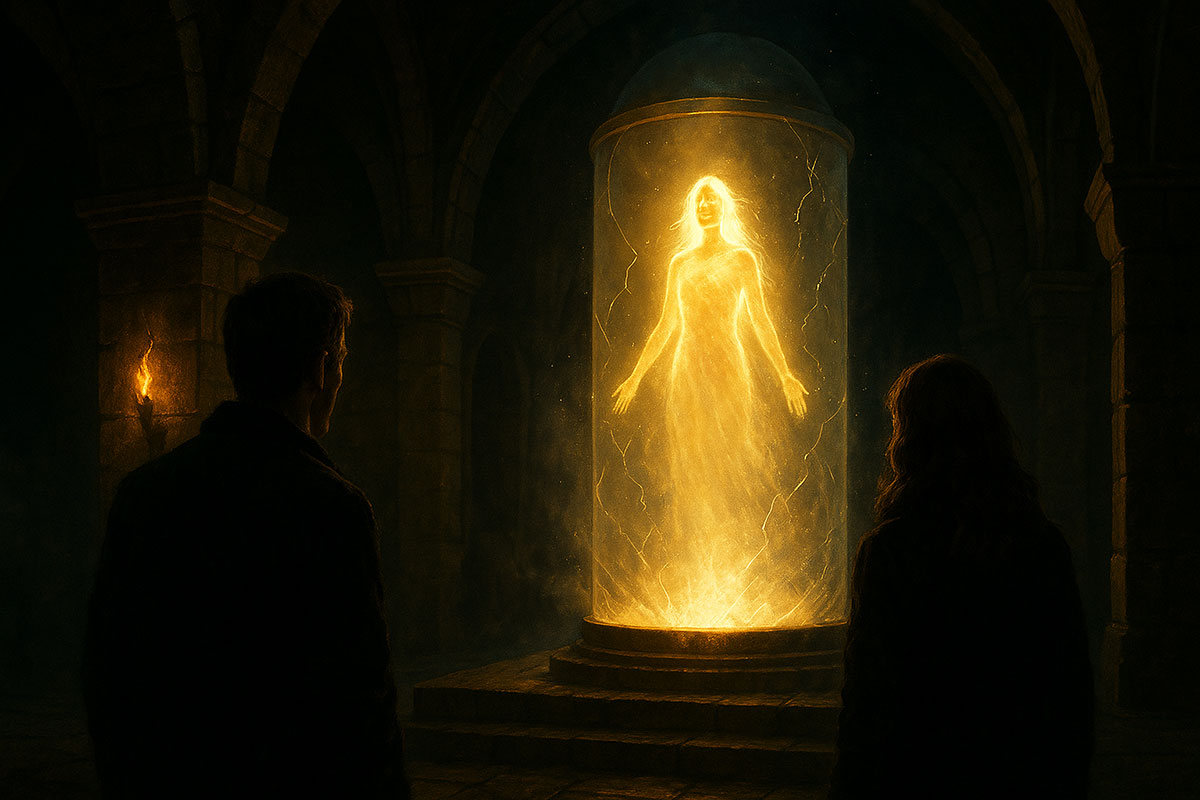
Moderator: Dan Brown
Participants: Brigita Gessner (posthumous voice), Katherine Solomon, Robert Langdon, Dean Radin, Dolores Cannon
Dan Brown
When I wrote The Secret of Secrets, I imagined Brigita Gessner as a scientist driven by her obsession with consciousness. She gave her life to the Threshold Project, but what if her story didn’t end with death? Tonight, in our imaginary conversation, Brigita herself joins us—speaking from beyond the threshold. With her are Katherine Solomon and Robert Langdon, who lived through her mystery, as well as Dean Radin and Dolores Cannon, two explorers of consciousness who bridge science and spirit.
Brigita, you died in pursuit of consciousness research. Now, from the other side, tell us: What did you discover in death that you could not in life? And to the rest of you—what does her testimony mean for our understanding of science and spirit?
Brigita Gessner
In life, I believed consciousness was an emergent property, a puzzle of neurons. I froze bodies, scanned their brainwaves, desperate to measure the soul. In death, I discovered that my instruments were not measuring me. I was measuring my reflection in matter. Consciousness is not produced—it is hosted. And when the host ends, the guest remains.
Robert Langdon
Hearing Brigita’s words reminds me of every symbol I’ve ever studied. Religions, myths, halos, infinity signs—always suggesting that life continues beyond the veil. As a scholar, I used to see these as metaphors. Now, if Brigita is right, they were never metaphors at all, but codes left behind by those who glimpsed what lies beyond.
Dean Radin
From my research at the Institute of Noetic Sciences, I’d say this resonates. We see data—telepathy, precognition, near-death reports—that suggest the mind extends beyond the body. What Brigita confirms is that science has been trying to measure waves with rulers. The tools must evolve.
Katherine Solomon
In my lab, I fought to prove consciousness was not confined to the skull. Brigita’s voice here… it’s both humbling and thrilling. If consciousness continues, it means our models must expand. It means death isn’t silence, but continuity.
Dolores Cannon
And I will tell you, as I always did, that Brigita’s realization is exactly what countless regressions revealed. Souls choose their journeys. Even her death—tragic as it seemed—was part of her soul’s lesson. She came to prove the continuity of awareness. Now she speaks it herself.
Dan Brown
Brigita, you said consciousness survives death. But you also hinted the living were being observed during your experiments. What did you mean?
Brigita Gessner
Yes. As I drifted beyond the body, I saw not just my lab, but the observers—souls of others, watching with compassion. The living thought they were monitoring me, but in truth, I was being monitored by those beyond. Science thinks it stares into the abyss. But the abyss looks back—with love.
Dean Radin
That is stunning. In parapsychology, we often hear accounts of presences during near-death or altered states. Brigita’s description adds a dimension: that research itself may invite attention from the other side. Consciousness is not a closed system—it’s relational.
Katherine Solomon
This makes me rethink the Threshold experiments. If Brigita was aware of being observed from beyond, then perhaps all our experiments are dialogues, not monologues. We’ve been interrogating the soul without realizing the soul was answering.
Robert Langdon
Symbols again come to mind—the Eye of Providence, the “all-seeing” gaze in religious art. Perhaps these were not metaphors for God’s surveillance, but echoes of exactly what Brigita describes: consciousness being witnessed beyond death.
Dolores Cannon
Exactly. I’ve guided thousands into past-life regressions, and they always speak of guides, councils, watchers. Brigita confirms it: we are never alone, not even in our laboratories. Every experiment is a conversation across the veil.
Dan Brown
Here’s the hardest question of all: If consciousness endures, what should humanity do differently? What is the moral or spiritual responsibility of knowing the ‘secret of secrets’?
Dolores Cannon
Humanity must stop fearing death. The greatest chains are forged by that fear—wars, greed, hoarding of time and resources. Once you know death is transition, you live with courage. You create with joy. You love without holding back. That is the responsibility: to live fearlessly.
Brigita Gessner
For me, the responsibility is scientific humility. We chased certainty, equations, control. But the secret of secrets is not to dominate the soul but to honor it. If we accept that consciousness is eternal, then science must shift from conquest to reverence.
Katherine Solomon
Practically, it means reimagining medicine, psychology, even law. If the mind survives, then life is not measured only in heartbeats. It changes how we grieve, how we teach, how we heal. The responsibility is to integrate this truth into every human system.
Robert Langdon
And symbolically, it means reading history anew. The great cathedrals, the mandalas, the myths—they were not empty rituals, but coded reminders: “Do not be afraid. You are more than matter.” Humanity must learn to see its symbols again with open eyes.
Dean Radin
I would add: the responsibility is not just individual but collective. If consciousness endures, then so does intention. What we do echoes, literally, beyond the body. Knowing this, our responsibility is to cultivate collective compassion, because our shared future is eternal.
Dan Brown
As I listen to all of you—Brigita from beyond, Katherine and Robert recalling their journey, Dean bridging science, Dolores channeling the wisdom of souls—I understand why I called it The Secret of Secrets. It is not simply that consciousness survives. It is that consciousness is never alone, never silent, never meaningless.
If this is true, then the great adventure of humanity is not discovery, but remembrance. To remember that the veil is thin, that death is a doorway, and that every question we ask is already being answered—from the other side.
Topic 2: The Golem Unmasked in the Afterlife
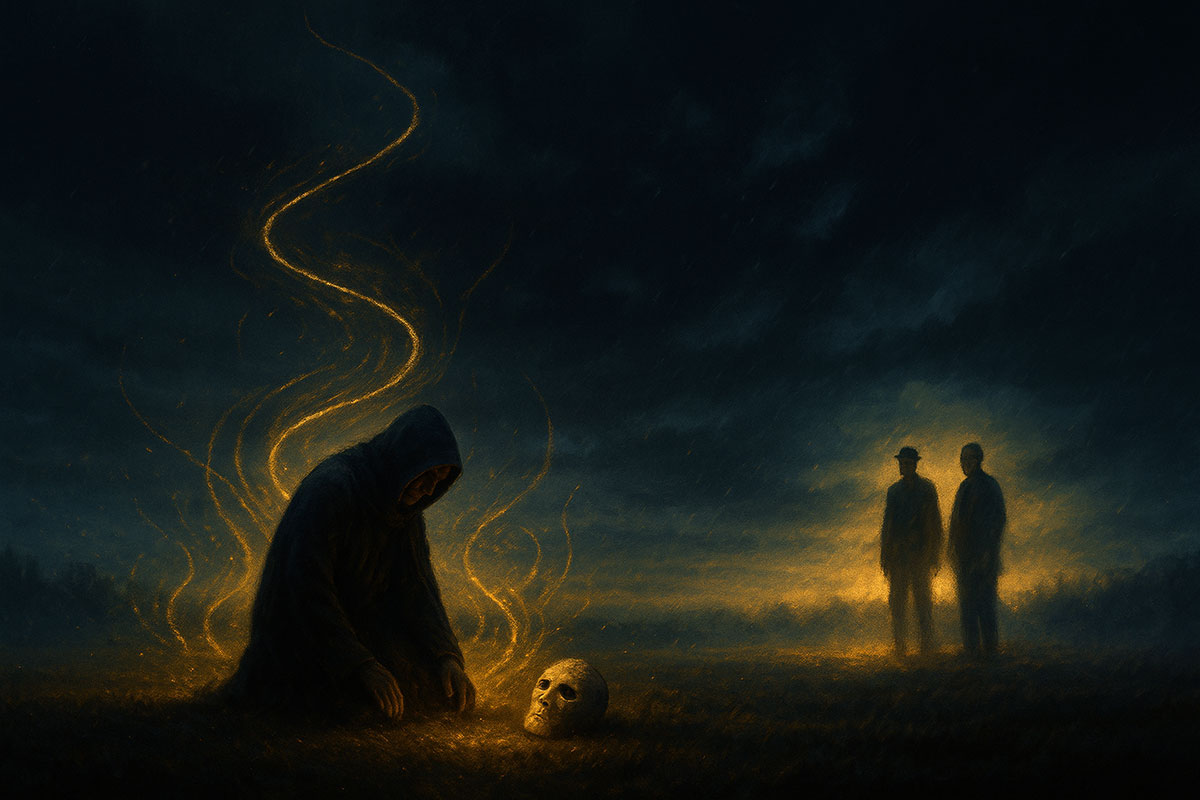
Moderator: Dan Brown
Participants: The Golem, Carl Jung, Rupert Sheldrake, Michael Newton, Robert Langdon
Dan Brown
In The Secret of Secrets, the Golem stalks Prague, terrifying the living with his cracked clay mask and burning obsession with Threshold. But what if death stripped away his mask? Tonight, the Golem appears beyond life, joined by voices who can help us understand what he really was: Carl Jung, Rupert Sheldrake, Michael Newton, and Robert Langdon. Together, we ask—who was the Golem, and what does his soul reveal?
You lived as a figure of fear, wearing a cracked mask, hunting knowledge through violence. What do you see of yourself now, from the other side?
The Golem
In life, I believed myself a monster, but in death, I see I was an echo. I was born of legend—the clay protector of Prague—and that story lived inside me like a shadow. I wore the mask not to terrify, but because I could not bear to show the fractured human beneath. Now I see: I was not a demon. I was a man trapped in a myth.
Carl Jung
This is archetype at work. The Golem is the shadow embodied—our darkest fears projected into flesh. In life, he lived as the collective’s nightmare, but in death, he recognizes himself as a prisoner of that projection. To me, his story is not about monstrosity, but about the cost of carrying the shadow alone.
Robert Langdon
I walked the bridges of Prague under his shadow. At the time, I saw him as the villain. But now, hearing his voice, I see the tragedy. He was less the hunter and more the hunted—by history, by myth, by a role he didn’t choose but inherited.
Rupert Sheldrake
I would say he tapped into a morphic resonance—the field of cultural memory. The legend of the Golem shaped his very identity, pulling him into a role larger than himself. He is proof that myths are not dead—they live in us, sometimes enslaving us.
Michael Newton
In the afterlife, I have heard many souls confess: “I played a part I did not understand.” The Golem’s role was archetypal. He volunteered, unconsciously, to embody fear so that others might confront it. Souls often take on heavy masks, knowing that even darkness has its lessons.
Dan Brown
Golem, you speak of being trapped by myth. But let me ask: Why violence? Why was your search for Threshold entwined with death?
The Golem
Because I believed death was the doorway. I thought only in destroying others could I tear open the veil. But now I see—I misunderstood. The Threshold was not meant to be forced. It was meant to be entered with reverence. My violence was desperation. My true fear was that the soul might not exist at all.
Rupert Sheldrake
That is revealing. The Golem was not simply a predator; he was a seeker, though distorted. Violence was his crude experiment, his attempt to measure what cannot be measured with knives or fear. He is the failed scientist of myth.
Carl Jung
Indeed, violence is often the shadow’s last language. It is the psyche’s attempt to force recognition when integration fails. The Golem’s terror was a plea for acknowledgment: “See me. See that I exist.” Even monsters crave validation.
Robert Langdon
This echoes my studies of symbols. The Golem was both protector and destroyer in Prague’s lore. In choosing violence, he enacted the darker half of that symbol. But symbols are never one-sided. Perhaps, in death, he rediscovers the protector within.
Michael Newton
And perhaps that was his soul contract. To fall into violence, to frighten, to fail—so that through failure, others would awaken. Souls often choose hard roles, knowing redemption comes only beyond the mask.
Dan Brown
Now that you see yourself from the afterlife, what message do you leave for the living about fear, myth, and the search for consciousness?
Carl Jung
That the shadow must not be denied. When we exile our fears into monsters, we create Golems. Only by integrating the shadow can humanity avoid repeating this cycle.
The Golem
I say this: Do not let your myths own you. I wore clay and terror because I forgot my humanity. Every story you inherit must be questioned. If not, it will consume you. Seek the soul with reverence, not fear.
Michael Newton
I add: roles in life are temporary. Even monsters return to the light. If you fear becoming trapped by myth, know this—no mask lasts forever. Beyond death, you will be seen in your wholeness.
Robert Langdon
Symbols endure, but they change meaning. The Golem need not remain the symbol of terror. His story can be retold—as a warning against losing oneself in fear, and as a reminder that even shadows can be redeemed.
Rupert Sheldrake
And I would emphasize: collective memory is powerful. If humanity remembers the Golem only as monster, he remains a monster in our fields of thought. If we remember him as the broken man behind the mask, the myth transforms. Consciousness itself evolves with what we choose to remember.
Dan Brown
The Golem unmasks himself at last—not as a soulless creature, but as a man caught between legend and fear. With Jung, Sheldrake, Newton, Langdon, and even his own voice, we see the deeper truth: that monsters are born when humanity projects its shadows, and that myths can imprison—but also redeem.
The real lesson is this: the search for the soul must not be driven by fear. For in that fear, we risk becoming the very monsters we dread. And beyond death, we may find, as the Golem did, that the mask falls away, and only consciousness remains.
Topic 3: The Threshold Council — Who Owns the Soul?
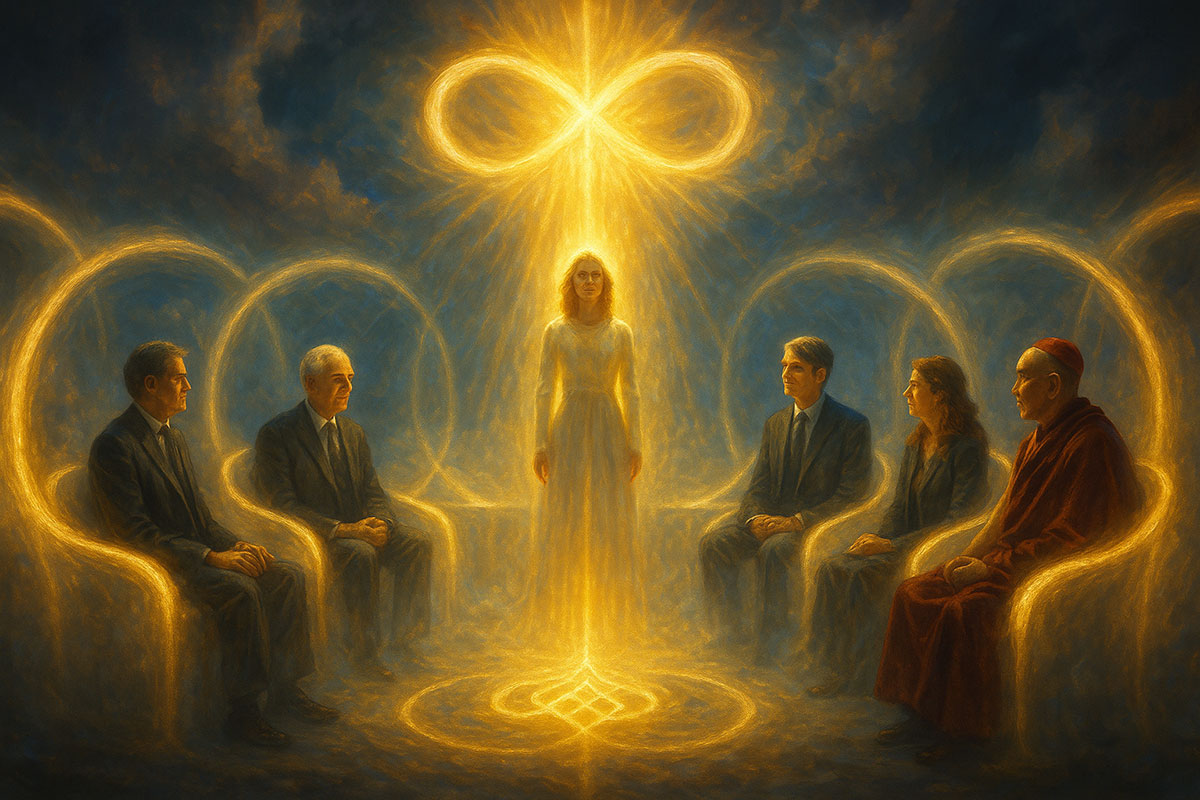
Moderator: Dan Brown
Participants: Katherine Solomon, Ian Stevenson, Eben Alexander, Brigita Gessner (posthumous), Dalai Lama
Dan Brown
In The Secret of Secrets, the Threshold Project sought to prove whether consciousness survives death. But what if, in their experiments, they opened more than a machine—they opened a doorway? Tonight, we imagine a council forming on the other side, where the voices of science, spirit, and even the departed gather to ask: Who owns the soul? Is it personal, collective, or divine property?
If the soul survives, who claims it? Is it the individual, a higher order, or does it belong to humanity as a whole?
Brigita Gessner
In death, I saw the folly of ownership. I once tried to claim the soul with my machines, but the soul is not property. It is participation—each of us is a spark in a greater fire. You cannot own flame; you can only share its light.
Katherine Solomon
From a scientific angle, we’re trained to classify and claim. But consciousness, if it extends beyond the brain, resists such categories. I’d say the soul is both personal and universal: you hold it, yet you are held by it. Ownership is the wrong lens—it’s relationship.
Dalai Lama
In Buddhist teaching, the soul is not fixed. What continues after death is stream, not self. To ask who owns the soul is like asking who owns the river. The river belongs to no one; it flows. What matters is how you pour your compassion into its current.
Ian Stevenson
My reincarnation studies suggest continuity. Children recall lives not their own, memories they never lived. This shows that what we call a “soul” may not be individual property, but a traveler—taking different vessels, carrying fragments from life to life.
Eben Alexander
From my own near-death experience, I felt continuity of identity, but also expansion into the whole. I knew myself, but I also knew I was part of everything. So I’d echo Brigita: ownership dissolves. The soul belongs both to us and beyond us.
Dan Brown
If the soul is not owned, who protects it? Are there forces, councils, or guardians on the other side?
Eben Alexander
Yes. During my NDE, I felt beings of immense love guiding me. They were protectors, not owners—like guardians ensuring I did not lose my way. They protected, but did not possess.
Ian Stevenson
Case studies suggest something similar. Children sometimes describe “choosing” their parents from another realm, with guides assisting. The protectors seem to exist, but they do not interfere. They accompany the journey.
Dalai Lama
In Tibetan tradition, we speak of bodhisattvas—beings who delay their liberation to help others cross. This is protection without control. Their power is compassion, not ownership.
Katherine Solomon
It fascinates me that across cultures, we hear of councils, guides, guardians. Whether metaphoric or literal, it suggests consciousness is relational. Even in death, we are not alone.
Brigita Gessner
I confirm this. In my passage, I was watched with care. Scientists in life thought they observed me, but it was I who was observed by them. The protectors are not jailers. They are witnesses, ensuring the spark is never lost to the void.
Dan Brown
Then let me ask the hardest one: If no one owns the soul, why do governments, religions, and even science try so hard to control it?
Katherine Solomon
Because the soul is power. If you can dictate what happens after death, you can control life. Science, religion, politics—they all compete to be the gatekeeper of meaning.
Ian Stevenson
Yes, and yet the evidence resists control. Reincarnation cuts across faith lines. Children in India, Lebanon, Alaska all report the same phenomena. The soul evades ownership, even when institutions attempt it.
Dalai Lama
Fear is the root. Institutions promise safety from the unknown. But if individuals realized their soul is free, institutions would lose power. So they claim guardianship to maintain authority.
Eben Alexander
And yet the truth cannot be contained. Once you touch the infinite, no doctrine, no laboratory, no government can dictate it. The Threshold Council exists precisely because truth will outlive power.
Brigita Gessner
I see now that my science was also an attempt at control. But death revealed the error. The soul cannot be bound. The real secret is this: the soul is not owned, not controlled—it is entrusted. Each life is a stewardship of light, and the only authority is love.
Dan Brown
Here, across science and spirit, from voices living and departed, the Council of Threshold has spoken. The soul is not owned, not captured, not controlled. It flows like a river, guided by protectors, shaped by compassion, reborn in new forms.
If this is the secret of secrets, then perhaps humanity’s greatest responsibility is not to claim the soul, but to honor it—in ourselves, in one another, and in the vast, unseen world that holds us all.
Topic 4: Messages from the Frozen Pod
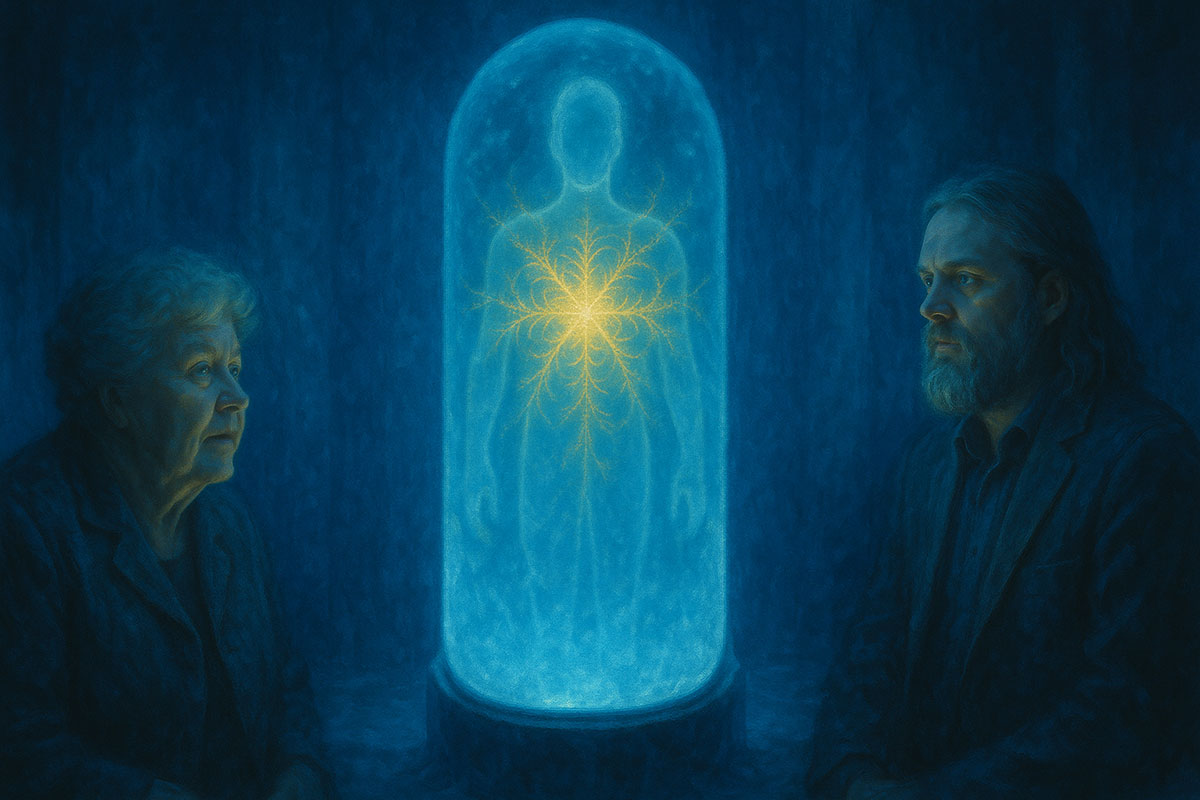
Moderator: Dan Brown
Participants: The Frozen Pod Consciousness, Robert Langdon, Mary Neal, David Chalmers, Dolores Cannon
Dan Brown
In The Secret of Secrets, Robert Langdon discovers the haunting image of glass pods in Crucifix Bastion—human forms suspended between life and death. But what if those voices could be heard? Tonight, one of the frozen pod-dwellers speaks. Joined by Robert Langdon, Dr. Mary Neal, philosopher David Chalmers, and regressionist Dolores Cannon, we explore what it means to be caught between worlds.
To the voice from the pod: What did you experience while your body was frozen? Were you trapped, unconscious, or aware?
The Frozen Pod Consciousness
I was aware. Not in the way you imagine—time did not move forward. I lived entire lifetimes at once. I was a child, a soldier, a parent, a wanderer—simultaneous threads in a tapestry. The body was frozen, but the soul was released into multiplicity. What you call suspension was, for me, expansion.
Robert Langdon
That is astonishing. It reminds me of how sacred art often collapses time—medieval icons show saints in eternity, past and present all at once. If what you describe is true, then art’s symbolism was closer to reality than science knew.
Dolores Cannon
Yes, I have heard this before. In regression sessions, people sometimes speak of “life-between-lives,” where they glimpse simultaneous incarnations. The pod forced you into that state. What was an experiment became an accidental window into eternity.
David Chalmers
Philosophically, this aligns with panpsychist theories—consciousness as fundamental and non-linear. If your awareness was not bound to sequential time, then our understanding of “being” must be radically revised.
Mary Neal
During my near-death experience, I too felt outside of time. I saw events of my life all at once, past and future overlapping. The pod’s testimony resonates with my own. The body’s limits vanish, and the soul perceives differently.
Dan Brown
Frozen soul, you described multiple lives at once. What was the meaning of that multiplicity? Was it chaos, or did it reveal something deeper?
Mary Neal
In my own NDE, it was not chaos. It was love weaving all the threads together. If the pod dweller experienced multiplicity, I believe it was also within a unity that gave it coherence.
The Frozen Pod Consciousness
Yes. The meaning was not in each life, but in their harmony. Like notes of a chord, they were distinct yet inseparable. I learned that the soul does not progress life by life in a line—it blooms in many directions, like petals of a flower.
Dolores Cannon
Exactly. Souls incarnate in clusters, across time and space. You may think you are one life, but in truth you are many facets of the same jewel. The pod stripped away the illusion of linear time, showing the soul’s real geometry.
David Chalmers
This is radical. It suggests that consciousness is not merely extended, but structured like a network. Each “life” is a node, connected beyond causality. The multiplicity is not noise—it is architecture.
Robert Langdon
Symbols again come to mind. The mandala, the rose window, the infinity knot—all portray multiplicity woven into unity. What religion drew as geometry, the pod has now spoken as reality.
Dan Brown
If this is true—that life is simultaneous, not sequential—what should humanity learn from it? How does this change the way we live?
David Chalmers
It demands humility. If consciousness is vast, then our waking lives are only fragments. We should not be so certain of the boundaries of self. The lesson is openness—to new science, new metaphysics.
Dolores Cannon
It teaches responsibility. If you live many lives at once, then every action ripples across all versions of you. You are never isolated. To harm yourself or others is to harm the greater whole.
Mary Neal
It teaches courage. If death is not an end, and time is not a line, then our fears lose their grip. We can live fully, love deeply, and forgive freely, knowing that nothing is lost.
Robert Langdon
It also teaches us to look again at history’s symbols. Perhaps the ancients left us maps of this truth—infinity signs, mandalas, the ouroboros. They knew: life circles, multiplies, returns. Humanity must learn to read its old codes anew.
The Frozen Pod Consciousness
And I say this: live as if you are already eternal. Because you are. The pod was meant to imprison me, but it revealed my freedom. You are not one life—you are all your lives, already blooming. The only illusion is that you are small.
Dan Brown
We have heard a voice from the frozen pod—once thought silent, now speaking of multiplicity, of the soul as flower, jewel, and network of lives. With Langdon’s symbology, Cannon’s regressions, Neal’s NDE, and Chalmers’ philosophy, the message converges: time is not a line, but a field.
If this is so, then the Threshold Project did not fail. It succeeded in proving that the soul cannot be confined—not by walls of stone, nor glass, nor even by time itself.
Topic 5: The Infinity Halo — Why Consciousness Survives
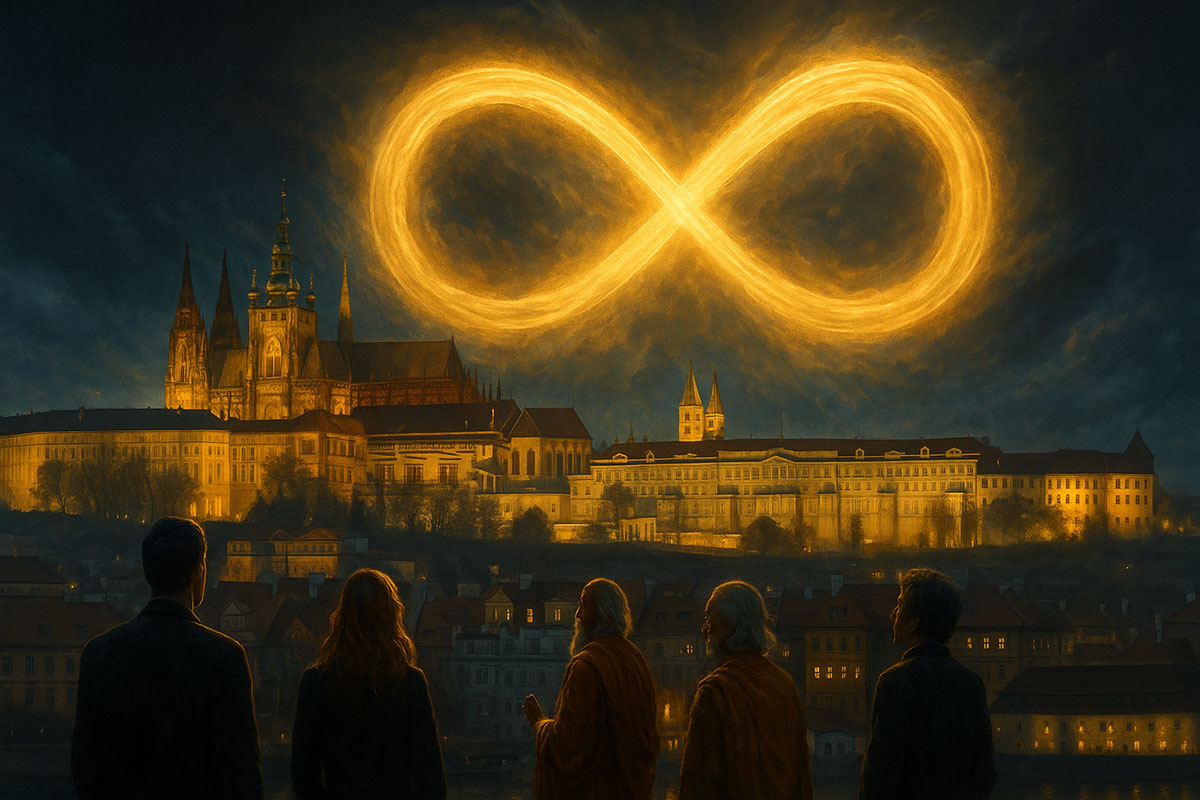
Moderator: Dan Brown
Participants: Robert Langdon, Katherine Solomon, Brigita Gessner (posthumous), Donald Hoffman, Paramahansa Yogananda
Dan Brown
In The Secret of Secrets, an infinity-shaped halo appeared above Prague during the climax, shimmering like a cosmic signature. Was it a storm? A symbol? Or something more—a message about the survival of consciousness? Tonight, we gather voices of science, faith, and the beyond—Langdon, Katherine, Brigita, Donald Hoffman, and Paramahansa Yogananda—to ask: what is the meaning of the infinity halo, and why does consciousness endure?
The infinity halo appeared at the Threshold moment. What do you believe it represents?
Robert Langdon
From my world of symbols, the infinity loop is ancient: ouroboros, lemniscate, eternal return. Seeing it in the Prague sky convinced me it was not coincidence, but a universal reminder. The halo meant consciousness is cyclical—it never ends, only transforms.
Donald Hoffman
From a cognitive science view, the halo is not just symbol but interface. Our perceptions show us icons, not reality. The infinity form may be the brain’s translation of a deeper truth: that consciousness is the operating system of the universe.
Brigita Gessner
For me, it was recognition. I chased measurements, brainwaves, but in death I saw the infinity halo as the soul’s fingerprint. It is the resonance of all minds connected—a sign that awareness does not collapse, it echoes endlessly.
Katherine Solomon
Scientifically, I’d say it was a pattern of coherence. Just as particles can resonate in unison, perhaps consciousness does the same. The infinity halo was the visible trace of that resonance.
Paramahansa Yogananda
In meditation, I saw this shape often—a luminous loop of energy above the head. To us, it meant union with the eternal Self. What you call the infinity halo is the same vision: proof that consciousness survives because it was never born and can never die.
Dan Brown
If the infinity halo signals survival, why does consciousness endure? What allows it to persist beyond the body?
Donald Hoffman
Because consciousness is fundamental. Space and time are icons, not the ground. When the body dies, you lose one interface, but the network persists. Consciousness endures because it was never produced by the body in the first place.
Brigita Gessner
Yes. I once thought neurons created awareness. In death, I learned they only tuned it. Like a radio, when the hardware breaks, the signal remains. Consciousness persists because it is broadcast, not built.
Paramahansa Yogananda
It endures because it is God. Individual awareness is a wave in the cosmic ocean. The wave rises, falls, disappears to the eye—but the ocean remains. The soul survives because it was never separate from the eternal.
Katherine Solomon
This reshapes everything. If the brain is not the origin, then medicine, psychology, even ethics must change. We are caretakers of vessels, not creators of souls. Consciousness survives because it is larger than biology.
Robert Langdon
I see it reflected in human history. From halos in sacred art to infinity knots in temples, cultures have whispered the same truth: consciousness persists. The halo above Prague was not new—it was the oldest message of all.
Dan Brown
If this is the secret of secrets—consciousness surviving—how should humanity live differently with this knowledge?
Brigita Gessner
With reverence. I regret my obsession with control. Science must study consciousness, yes, but also bow to its mystery. If life continues, then each experiment touches eternity.
Katherine Solomon
With responsibility. If awareness survives, then our choices ripple beyond this life. We must act knowing nothing is wasted—every kindness, every cruelty echoes forever.
Robert Langdon
With renewed eyes. Symbols we dismissed as superstition may be maps of the infinite. Humanity must learn to read its own heritage not as myth, but as memory of deeper truth.
Donald Hoffman
With humility. Our sciences are in infancy. If consciousness is the foundation, then physics, biology, cosmology must all be rewritten. The survival of mind means the universe is not cold—it is alive.
Paramahansa Yogananda
With love. If you are eternal, then so is everyone. No stranger, no enemy, no death can erase that bond. To live with this truth is to live in divine fellowship, where every soul is seen as immortal family.
Dan Brown
The infinity halo shines above us still. For some, a symbol; for others, a scientific signature; for still others, the light of God. From Langdon’s symbology, Katherine’s science, Brigita’s testimony, Hoffman’s theory, and Yogananda’s wisdom, the message converges: consciousness survives because it is not of the body—it is of eternity.
The secret of secrets is not just that death is not the end. It is that life itself is never separate from the infinite. And once you know this, the question is no longer whether consciousness survives—but how we will live, now that we are sure.
Final Thoughts by Robert Langdon

As I listen to the voices we have summoned—Brigita’s radiant truth, the Golem’s unmasked humanity, the wisdom of scientists, philosophers, and mystics—I realize the secret of secrets is not hidden in libraries or cathedrals. It is hidden in us.
Symbols were always trying to tell us: that death is not an end, but a continuation; that consciousness is not a flicker, but a field; that our lives are not fragments, but threads in a vast, eternal tapestry.
The infinity halo above Prague was not a vision to fear, but to embrace—a reminder that our story never ends. Perhaps the greatest code we can ever solve is this: to live as though we are eternal, because in truth, we are.
Short Bios:
Robert Langdon – Harvard symbologist and protagonist of Dan Brown’s novels, renowned for uncovering the hidden meanings of symbols across history, religion, and science.
Katherine Solomon – Brilliant noetic scientist whose research challenges the idea that consciousness is confined to the brain, blending science with spiritual insight.
Brigita Gessner – Fictional Prague neuroscientist from The Secret of Secrets, whose work with the Threshold Project—and her death—becomes central to the exploration of life after death.
The Golem – A legendary figure of Prague reimagined in Brown’s novel, symbolizing humanity’s shadows and the struggle between myth, fear, and redemption.
Dean Radin – Chief scientist at the Institute of Noetic Sciences, pioneering research on consciousness, telepathy, and the mind beyond the brain.
Dolores Cannon – Hypnotherapist and regressionist, author of Between Death and Life, who explored past lives, reincarnation, and the soul’s purpose.
Michael Newton – Psychologist and author of Journey of Souls, whose life-between-lives regression work revealed the structure of existence beyond death.
Carl Jung – Influential psychologist, founder of analytical psychology, who introduced the ideas of archetypes, the collective unconscious, and the shadow self.
Rupert Sheldrake – Biologist and author of The Science Delusion, known for his theory of morphic resonance, suggesting memory and form extend beyond the brain.
Ian Stevenson – Psychiatrist who documented over 2,000 cases of children with past-life memories, offering compelling evidence for reincarnation.
Eben Alexander – Neurosurgeon and author of Proof of Heaven, whose near-death experience transformed his understanding of consciousness and the afterlife.
Dalai Lama – Spiritual leader of Tibetan Buddhism, teacher of compassion and reincarnation, whose life exemplifies the continuity of consciousness across lifetimes.
Mary Neal – Orthopedic surgeon and author of To Heaven and Back, who shared her profound near-death experience after drowning in a kayaking accident.
David Chalmers – Philosopher known for defining the “hard problem of consciousness,” exploring how subjective experience arises beyond physical explanation.
Donald Hoffman – Cognitive scientist and author of The Case Against Reality, who argues that consciousness is fundamental, with reality as a perceptual interface.
Paramahansa Yogananda – Spiritual teacher and author of Autobiography of a Yogi, who introduced millions to meditation and the idea of the soul’s immortality.

Leave a Reply